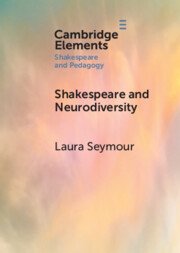Refine search
Actions for selected content:
29 results
The experiences of autistic adolescents in a dialectical behaviour therapy programme: a qualitative study utilising thematic analysis
-
- Journal:
- The Cognitive Behaviour Therapist / Volume 18 / 2025
- Published online by Cambridge University Press:
- 14 October 2025, e52
-
- Article
-
- You have access
- Open access
- HTML
- Export citation

Human Cognitive Diversity
-
- Published online:
- 05 August 2025
- Print publication:
- 04 September 2025
-
- Element
- Export citation
4 - The Second Bridge
-
- Book:
- Disability, Human Rights, and Contract Law
- Published online:
- 06 August 2025
- Print publication:
- 31 July 2025, pp 92-164
-
- Chapter
- Export citation
Supporting neurodivergent doctors to thrive at work
-
- Journal:
- BJPsych Advances , FirstView
- Published online by Cambridge University Press:
- 28 July 2025, pp. 1-12
-
- Article
-
- You have access
- Open access
- HTML
- Export citation
Chapter 3 - Convulsive Aesthetics: Charcot, Chaplin, and Gilles de la Tourette
-
- Book:
- Samuel Beckett and Medicine
- Published online:
- 20 June 2025
- Print publication:
- 03 July 2025, pp 58-76
-
- Chapter
- Export citation
16 - The Many Paths of Development
- from Section III - Adolescence
-
- Book:
- Child Development
- Published online:
- 19 June 2025
- Print publication:
- 12 June 2025, pp 239-258
-
- Chapter
- Export citation
Chapter 14 - Autism
- from Part Four - How Music Helps with Illness
-
- Book:
- Good Vibrations
- Published online:
- 01 May 2025
- Print publication:
- 22 May 2025, pp 255-265
-
- Chapter
- Export citation
2 - When Does Hoarding Arise?
-
- Book:
- Everything You Need to Know About Hoarding
- Published online:
- 10 April 2025
- Print publication:
- 10 April 2025, pp 15-31
-
- Chapter
- Export citation

Shakespeare and Neurodiversity
-
- Published online:
- 10 January 2025
- Print publication:
- 06 February 2025
-
- Element
- Export citation
Neurodiversity and inclusive social value management practices
-
- Journal:
- Journal of Management & Organization / Volume 31 / Issue 1 / January 2025
- Published online by Cambridge University Press:
- 19 November 2024, pp. 298-306
-
- Article
-
- You have access
- Open access
- HTML
- Export citation
Eating Disorder and Autism Collaborative project outline: promoting eating disorder research embedded in a neurodiversity-affirming culture
-
- Journal:
- BJPsych Bulletin / Volume 49 / Issue 4 / August 2025
- Published online by Cambridge University Press:
- 08 August 2024, pp. 272-277
- Print publication:
- August 2025
-
- Article
-
- You have access
- Open access
- HTML
- Export citation
10 - Cognitive Individual Differences
-
- Book:
- A Practical Guide to Second Language Teaching and Learning
- Published online:
- 03 May 2024
- Print publication:
- 30 May 2024, pp 214-238
-
- Chapter
- Export citation
Participatory translational science of neurodivergence: model for attention-deficit/hyperactivity disorder and autism research
-
- Journal:
- The British Journal of Psychiatry / Volume 224 / Issue 4 / April 2024
- Published online by Cambridge University Press:
- 16 February 2024, pp. 127-131
- Print publication:
- April 2024
-
- Article
-
- You have access
- Open access
- HTML
- Export citation
Chapter 10 - Neurodiversity
-
- Book:
- Improving University Mental Health
- Published online:
- 08 February 2024
- Print publication:
- 15 February 2024, pp 136-159
-
- Chapter
- Export citation
1 - Introduction
- from Part I
-
- Book:
- Succeeding and Adult Dyslexia
- Published online:
- 11 January 2024
- Print publication:
- 01 February 2024, pp 3-24
-
- Chapter
- Export citation
Conclusion - (Re)Creating Ritual Experiences
-
-
- Book:
- Senses, Cognition, and Ritual Experience in the Roman World
- Published online:
- 04 January 2024
- Print publication:
- 25 January 2024, pp 200-224
-
- Chapter
-
- You have access
- Open access
- HTML
- Export citation
A response to the terms in Shah et al's ‘Neurodevelopmental disorders and neurodiversity: definition of terms from Scotland's National Autism Implementation Team’
-
- Journal:
- The British Journal of Psychiatry / Volume 222 / Issue 4 / April 2023
- Published online by Cambridge University Press:
- 20 March 2023, pp. 157-159
- Print publication:
- April 2023
-
- Article
-
- You have access
- HTML
- Export citation
Neurodiversity in the workplace: Considering neuroatypicality as a form of diversity
-
- Journal:
- Industrial and Organizational Psychology / Volume 16 / Issue 1 / March 2023
- Published online by Cambridge University Press:
- 09 March 2023, pp. 1-19
-
- Article
- Export citation
Using network analysis to improve understanding and utility of the 10-item Autism-Spectrum Quotient
-
- Journal:
- Experimental Results / Volume 3 / 2022
- Published online by Cambridge University Press:
- 28 July 2022, e12
-
- Article
-
- You have access
- Open access
- HTML
- Export citation
17 - Neurodiversity
- from Part III - Interaction and Inclusion
-
-
- Book:
- Talking with Children
- Published online:
- 16 June 2022
- Print publication:
- 30 June 2022, pp 352-367
-
- Chapter
- Export citation
